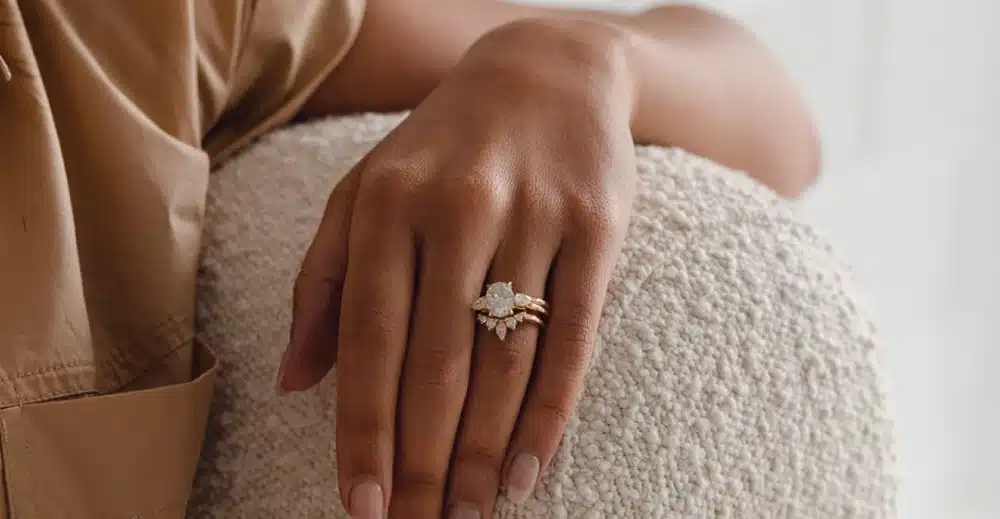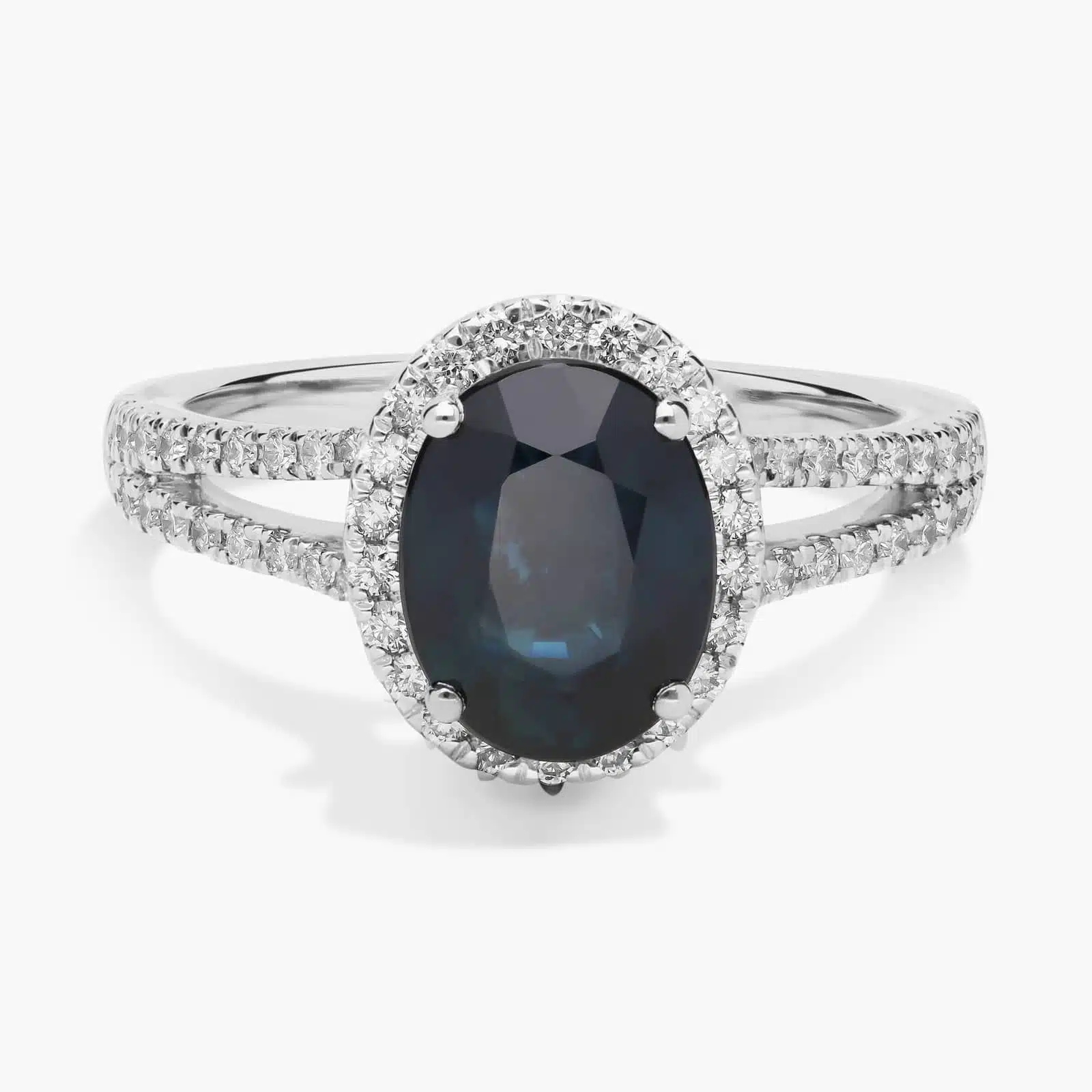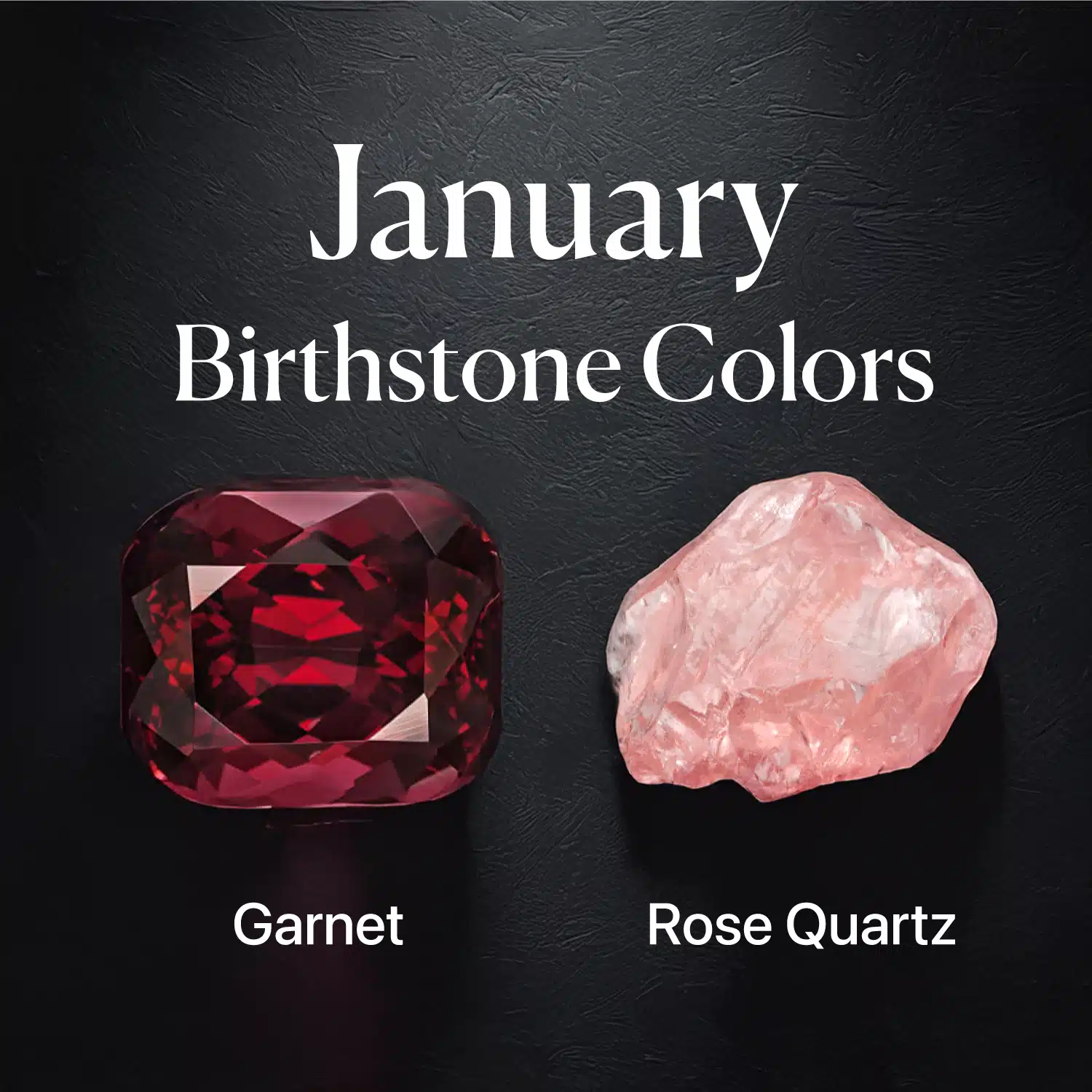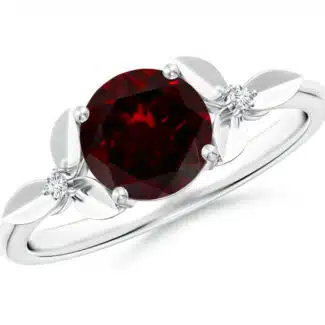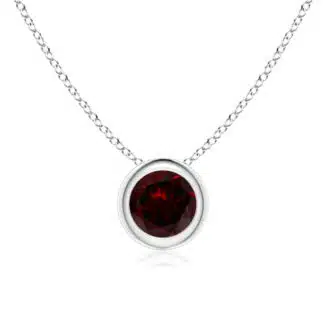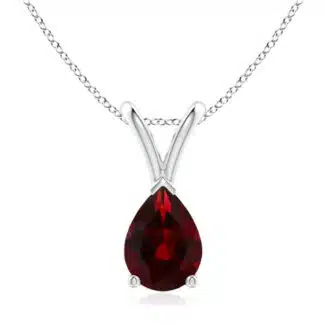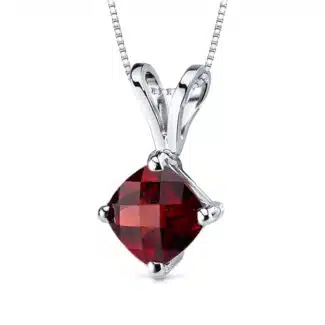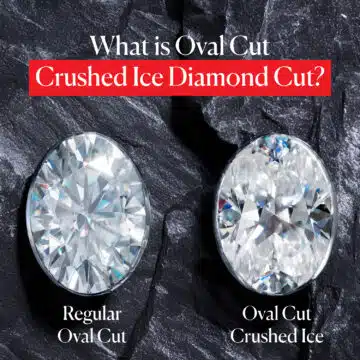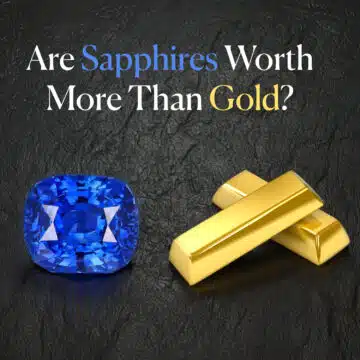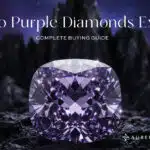What is January birthstone color? Garnet’s fiery reds and beyond will captivate you! As January’s primary birthstone, garnet is celebrated for its deep, pomegranate-red brilliance but surprises with green, pink, and even rare blue shades.
For those craving a softer touch, rose quartz, a gentle pink alternative, adds emotional depth for January-born individuals. A birthstone’s color defines its charm, value, and personal resonance, guiding your jewelry choices.
I will dive into garnet’s vibrant varieties, rose quartz’s soothing allure, their meanings, properties, and styling tips, complete with a comparison table to simplify your decision. I once saw a tsavorite garnet ring light up a room, perfect for a January birthday!
Curious about other birthstone hues? June’s gems shine uniquely at birthstone hues. Join me to uncover January’s gemstone treasures!
- Exploring January’s Birthstone: Garnet’s Vibrant World
- Garnet’s Color Palette: Beyond Red
- Almandine Garnet: How to Buy, Meanings, Properties & Facts
- Pyrope Garnet: How to Buy, Meanings, Properties & Facts
- Rhodolite Garnet: How to Buy, Meanings, Properties & Facts
- Tsavorite Garnet: How to Buy, Meanings, Properties & Facts
- Demantoid Garnet: How to Buy, Meanings, Properties & Facts
- Grossular Garnet: How to Buy, Meanings, Properties & Facts
- Star Garnet: How to Buy, Meanings, Properties & Facts
- All Garnets Comparison: January’s Vibrant Birthstones
- Recommended products
- Recommended products
- Rose Quartz: January’s Alternative Birthstone
- Recommended products
- How Color Impacts January Birthstone Value
- January Birthstone Jewelry Styling Tips
- FAQ's about January Birthstones
- Conclusion: Celebrate January with Garnet and Rose Quartz
Exploring January’s Birthstone: Garnet’s Vibrant World

Garnet, January’s dazzling birthstone, sparkles with a spectrum of colors and a storied past. This silicate mineral group, named from the Latin “granatus” for its pomegranate-seed red hue, stands as January’s traditional and modern gem, symbolizing love, protection, and resilience.
Its geological origins and cultural significance elevate garnet beyond mere beauty, making it a treasure for jewelry lovers. As the founder of Moissanite by Aurelia, I’ve seen garnet’s allure inspire countless designs.
Explore January birthstone jewelry to embrace garnet’s charm at January birthstone jewelry. Let’s uncover the magic of this January gemstone!
Garnet’s Geological Roots
Garnet forms deep within the Earth, shaped by extreme conditions that define its brilliance.
- Formation: Crystallizes in metamorphic and igneous rocks under intense heat and pressure.
- Sources: Found in Tanzania, India, Sri Lanka, and Idaho, each yielding distinct varieties.
- Fact: Garnets graced Egyptian pharaohs’ jewelry around 3100 B.C., proving their enduring appeal.
With a Mohs hardness of 6.5-7.5, garnet balances durability and versatility, perfect for rings or pendants, though softer than sapphires or rubies. Its resilience makes it a timeless choice.
Global Mining Insights
Mining regions infuse garnet with unique traits. Tanzania offers vivid tsavorite, rivaling emeralds in green splendor, while Idaho’s star garnets shimmer with celestial patterns.
Sri Lanka’s rare color-change garnets, shifting hues under light, captivate collectors. These origins showcase garnet’s global diversity, ensuring a January birthstone for every style.
Garnet’s Cultural Legacy
Garnet’s legacy spans centuries, weaving through human history with profound meaning. Romans carved it into signet rings to seal promises, medieval warriors wore it for safety, and Victorians cherished its elegance in ornate designs.
- Symbolism: Embodies trust, friendship, and love, often gifted for the 2nd wedding anniversary.
- Fact: Ancient healers believed garnet shielded against harm, a belief echoed in tribal traditions.
My experience crafting jewelry at Moissanite by Aurelia confirms garnet’s power to connect wearers to its rich heritage, blending ancient symbolism with modern flair.
Garnet’s Color Palette: Beyond Red

Garnet, January’s cherished birthstone, shatters the myth that it’s only red. This gemstone dances across a breathtaking spectrum—lush greens, fiery oranges, soft pinks, regal purples, and even rare blues—each hue a testament to its versatility.
I’ve witnessed garnet’s vibrant shades captivate jewelry lovers, offering something for every taste. Its colors, born from trace elements like iron, chromium, or vanadium, create a visual symphony that defines January gemstone hues. Imagine a garnet shifting from green to purple under changing lights—pure enchantment!
Whether you seek bold or subtle January birthstone colors, garnet delivers unmatched charm. Love vibrant gem hues? Pink sapphires rival garnet’s allure at vibrant gem hues. Join me to uncover the science, rarity, and value behind garnet’s stunning color range, a true gift for January-born.
The Science of Garnet Colors
Garnet’s kaleidoscope of shades springs from its chemical composition, where minute elements craft a rainbow of possibilities. These natural processes make every garnet a unique masterpiece, perfect for January birthstone jewelry.
- Iron’s Warm Reds: Powers almandine’s deep, pomegranate-like glow, the quintessential garnet birthstone color.
- Chromium’s Vivid Greens: Ignites tsavorite’s emerald-rivaling brilliance, a gem that turns heads.
- Vanadium’s Color-Change Magic: Drives the rarest garnets to shift hues, a phenomenon that mesmerizes collectors.
- Fact: Blue garnets, discovered in Madagascar in the 1990s, command ~$1,500 per carat due to their scarcity.
This chemistry, honed over millions of years, ensures garnet’s colors are as diverse as the emotions they evoke. From fiery reds to serene greens, these shades reflect garnet’s ability to suit any style, whether in a bold ring or delicate pendant.
My readers at Moissanite by Aurelia often marvel at how a single gemstone family can offer such variety, making garnet a standout choice for January.
Ignite your passions with our Crush On You Ring, featuring fiery Ruby and Garnet. This dynamic duo promotes vitality, courage, and enthusiasm, empowering you to pursue your dreams with confidence. Get ready to turn heads—soon, everyone will have a crush on you!
Key Features:
- Ruby & Garnet Gemstones: A powerful combination that enhances vitality and courage.
- Passion-Driven Design: Symbolizes the pursuit of your goals and passions.
- Handcrafted Excellence: Each ring is crafted with precision and care.
- Statement Piece: Perfect for making a bold and confident impression.
The Crush On You Ring is your go-to accessory for channeling energy and enthusiasm.
Color-Change Garnet Magic
Color-change garnets are nature’s shape-shifters, transitioning from blue-green in daylight to purple-red under incandescent light. These gems, rarer than diamonds, hold a special place in the hearts of collectors and jewelers.
Their dynamic hues, caused by vanadium’s interplay with light, make them a coveted choice for statement pieces. At Moissanite by Aurelia, I’ve seen clients light up when trying on a color-change garnet necklace, its hues dancing with every movement.
This rarity elevates January birthstone colors to a level of prestige, perfect for those seeking a gem as unique as they are. Their scarcity—found primarily in Sri Lanka and Tanzania—adds to their allure, making them a collector’s dream and a conversation starter.
Why Color Matters
A garnet’s color isn’t just about beauty; it shapes its value, appeal, and emotional resonance. Vivid, saturated hues like tsavorite’s emerald green or rhodolite’s pinkish-red fetch premium prices compared to muted tones, such as brownish almandine.
For instance, a 1-carat tsavorite can cost ~$1,200, while almandine hovers at ~$200. Bright colors signal rarity, clarity, and desirability, driving both market worth and personal connection. I’ve noticed clients gravitate toward vibrant January birthstone colors that reflect their personality—whether it’s pyrope’s fiery red for passion or grossular’s sunny orange for optimism.
Color also influences jewelry design: bold greens shine in platinum, while soft pinks glow in rose gold. Garnet’s diverse palette ensures there’s a shade for every January-born soul, making it a gemstone that speaks to both heart and style. Choosing the right hue transforms a piece into a lifelong treasure, blending aesthetics with meaning.
Almandine Garnet: How to Buy, Meanings, Properties & Facts
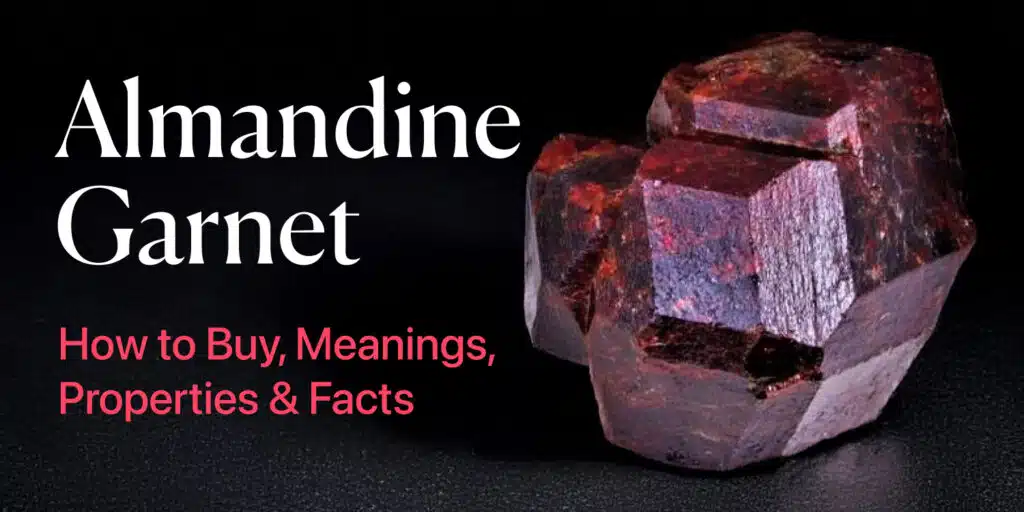
Almandine garnet, January’s most iconic birthstone, glows with a deep red to scarlet hue, often kissed by earthy brown undertones. As a jewelry expert, I’ve seen this gem’s rich, warm tones steal hearts, offering an affordable yet striking choice for January-born.
Mined across India, Brazil, and Australia, almandine’s accessibility makes it a favorite for rings, pendants, and earrings. Its name, derived from “Alabanda,” an ancient Turkish gem-cutting hub, hints at its storied past. Symbolizing courage and grounding, almandine connects wearers to the Earth’s steady pulse. Curious about crafting your own piece?
Shop almandine garnet jewelry for timeless elegance at almandine garnet jewelry. Let’s explore almandine’s spiritual depth, historical roots, and practical tips to choose the perfect stone, ensuring you find a January birthstone that resonates with your style and soul.
Almandine’s Symbolism and Meanings
Almandine garnet’s deep red radiance carries profound emotional and spiritual weight, making it a cherished January birthstone. Tied to the root chakra, it fosters grounding, courage, and stability, helping wearers feel anchored in turbulent times. Its rich hue evokes passion and loyalty, often gifted to strengthen bonds of love or friendship.
- Emotional Power: Promotes self-confidence and resilience, ideal for facing life’s challenges.
- Spiritual Role: Aligns with grounding energies, connecting wearers to their core strength.
- Fact: Vikings believed almandine guided souls to the afterlife, embedding it in burial rituals.
This gem’s ability to inspire steadfastness has made it a timeless symbol across cultures. I’ve noticed clients drawn to almandine for its warm, reassuring glow, choosing it for pieces that carry personal meaning, like a necklace worn daily or a ring marking a milestone. Its symbolism elevates almandine beyond beauty, into a realm of emotional connection.
Almandine in Ancient Cultures
Almandine’s legacy stretches back centuries, woven into the fabric of ancient societies. In Mesopotamia, it adorned royal jewelry, symbolizing power and divine favor. Gothic artisans crafted almandine into intricate cloisonné designs, showcasing its regal depth.
Warriors across cultures, from Celts to Crusaders, wore almandine talismans, believing its red glow ensured victory and safe return. This historical reverence underscores almandine’s enduring appeal as a January birthstone, blending strength with elegance.
Its presence in ancient relics, now displayed in museums, sparks awe among modern gem enthusiasts, reminding us of its timeless significance.
Properties and Buying Tips
Almandine garnet’s physical traits make it a practical yet stunning choice for jewelry, balancing durability with affordability. Understanding its properties and how to select a quality stone ensures you invest in a piece that lasts.
- Hardness: Mohs 7-7.5, tough enough for daily wear in rings or bracelets.
- Clarity: Transparent to translucent, with minor inclusions adding character.
- Color Quality: Seek rich, pure reds; avoid overly brown tones for maximum vibrancy.
- Fact: Almandine’s deep red starred in Victorian brooches, prized for its royal allure.
When buying, prioritize stones with vivid red hues and minimal inclusions for brilliance. A 1-carat almandine typically costs ~$200 at James Allen, making it a budget-friendly gem.
Check for even color distribution under natural light, as some stones may appear too dark. Pair almandine with yellow gold to enhance its warmth or silver for a bold contrast. At Aurelia, I recommend choosing certified stones from reputable sellers to ensure authenticity.
Avoid overpaying for heavily included gems, and always verify the stone’s origin for ethical sourcing. Almandine’s versatility suits everything from classic solitaires to modern stackable rings, offering endless ways to celebrate January’s birthstone.
Whether you’re buying for yourself or gifting a loved one, almandine’s blend of beauty, meaning, and value makes it a standout choice.
Pyrope Garnet: How to Buy, Meanings, Properties & Facts
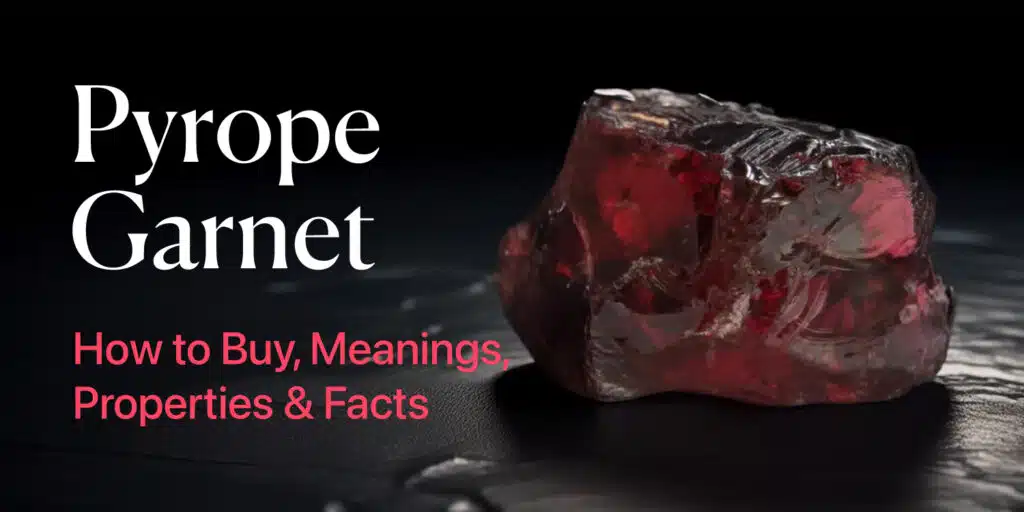
Pyrope garnet, a January birthstone gem, ignites passion with its fiery crimson to rose-red hues, earning its name from the Greek “pyropos,” meaning fire-eyed. As a jewelry expert, I’m captivated by pyrope’s intense brilliance, which rivals rubies in sparkle but at a fraction of the cost.
Sourced from the Czech Republic, South Africa, and Arizona, this gem’s vivid glow makes it a standout for necklaces, rings, and earrings. Its deep red tones symbolize vitality and love, resonating with January-born souls seeking bold expression.
A pyrope garnet necklace adds fiery flair at pyrope garnet necklace. Let’s dive into pyrope’s spiritual depth, historical charm, and practical buying tips to help you select a January birthstone that shines with meaning and style, ensuring your jewelry reflects both heart and heritage.
Pyrope’s Spiritual Significance
Pyrope garnet’s radiant red connects deeply with the heart chakra, sparking vitality, passion, and emotional warmth. This January birthstone energizes wearers, fostering love and courage in relationships and personal pursuits.
Its fiery hue is believed to ignite inner strength, making it a talisman for those chasing dreams or overcoming challenges.
- Emotional Impact: Enhances confidence and devotion, perfect for romantic gifts.
- Spiritual Energy: Channels passion, aligning with the heart’s deepest desires.
- Fact: Bohemian artisans in the 19th century prized pyrope for its “blood of fire,” crafting it into amulets.
Clients often choose pyrope for its uplifting energy, whether in a bold pendant or a delicate ring. Its ability to evoke warmth and connection makes it a cherished January gem, blending spiritual significance with striking beauty that resonates across generations.
Pyrope in European History
Pyrope’s legacy glows brightly in European history, particularly in the Czech Republic’s Bohemia region. In the 19th century, it starred in ornate jewelry, from brooches to tiaras, symbolizing passion and nobility. Often set in rose gold, pyrope adorned royalty and aristocrats, its crimson sparkle a mark of prestige.
The Czech crown jewels feature pyrope, showcasing its cultural weight. This historical allure continues to inspire modern designs, with pyrope’s fiery red adding drama to contemporary pieces. Its prominence in European craftsmanship underscores its status as a January birthstone with a royal pedigree, captivating collectors and romantics alike.
Properties and Buying Guide
Pyrope garnet’s physical traits make it a durable, brilliant choice for jewelry, offering affordability without sacrificing quality. Knowing its properties and how to buy ensures you pick a stone that dazzles for years.
- Hardness: Mohs 7-7.5, ideal for daily wear in earrings or rings.
- Clarity: Often inclusion-free, delivering exceptional sparkle and transparency.
- Color Quality: Seek vivid crimson or rose-red hues for maximum impact; avoid dull tones.
- Fact: Pyrope’s brilliance graced the Smithsonian’s antique hair comb, a testament to its elegance.
When purchasing, prioritize stones with intense red color and high clarity for optimal fire.
A 1-carat pyrope averages ~$300 at Blue Nile, offering value for vibrant gems. Examine stones under varied lighting to ensure consistent color, as some may appear darker indoors. Pair pyrope with white gold for a modern look or rose gold to amplify its warmth.
Opt for certified stones from trusted retailers like James Allen to guarantee authenticity and ethical sourcing. For budget-friendly options, check Amazon gemstone jewelry, but verify seller ratings to avoid low-quality stones. Avoid stones with visible inclusions, as they dim pyrope’s signature sparkle.
Pyrope suits versatile designs, from solitaire pendants to gemstone-studded bracelets, making it a dynamic January birthstone choice. Whether for a birthday gift or personal treasure, pyrope’s blend of durability, beauty, and affordability ensures a piece that endures in both style and sentiment.
Rhodolite Garnet: How to Buy, Meanings, Properties & Facts
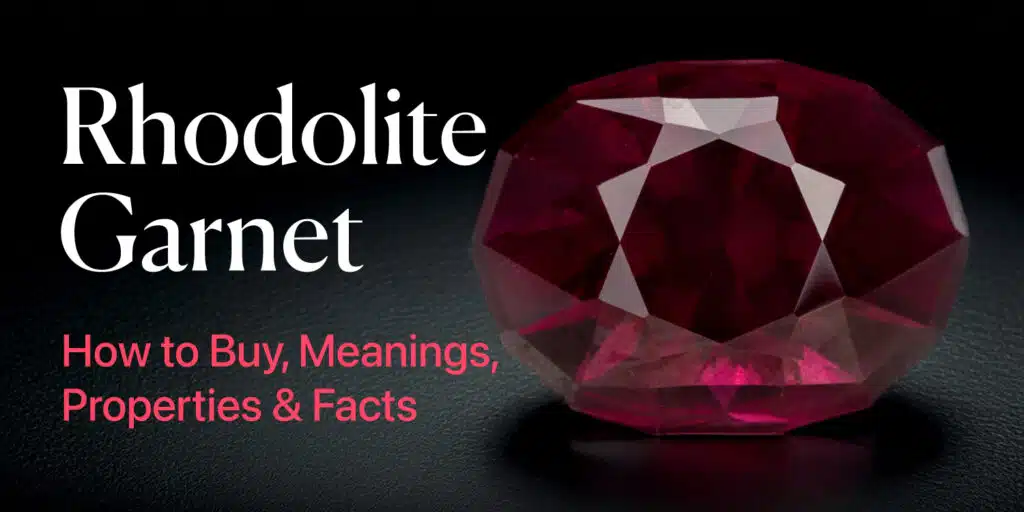
Rhodolite garnet, a January birthstone, captivates with its purplish-red to pinkish-red glow, blending the fiery depth of pyrope and the earthy warmth of almandine. As a jewelry expert, I’m enchanted by rhodolite’s romantic hues, which make it a versatile gem for pendants, rings, and bracelets.
Mined in Tanzania, Sri Lanka, and North Carolina, this gem’s vibrant sparkle suits both bold and delicate designs. Its name, from the Greek “rhodon” for rose, reflects its floral-like charm, symbolizing compassion and balance.
Rhodolite’s allure lies in its ability to bridge passion and serenity, perfect for January-born romantics. Let’s explore rhodolite’s emotional resonance, modern appeal, and practical buying tips to help you choose a January birthstone that radiates love and elegance.
Rhodolite’s Emotional Power
Rhodolite garnet’s pinkish-red tones pulse with emotional and spiritual energy, making it a cherished January birthstone. Aligned with the heart chakra, it nurtures compassion, emotional balance, and self-love, encouraging wearers to embrace their inner warmth.
Its gentle yet vibrant hue fosters harmony in relationships and inspires creativity, making it a gem for artists and lovers alike.
- Rhodolite promotes empathy, strengthening bonds with others.
- It enhances emotional clarity, aiding in heartfelt decisions.
- Fact: In Tanzania’s Umba Valley, rhodolite’s “spirit color” pink-violet shade is a collector’s treasure.
I’ve seen clients gravitate toward rhodolite for its soothing yet uplifting energy, often choosing it for gifts that carry deep sentimental value, like an anniversary ring or a pendant worn close to the heart.
This gem’s ability to blend passion with tranquility makes it a standout choice for January’s birthstone jewelry, resonating with those seeking meaningful connections.
Rhodolite’s Modern Appeal
Rhodolite garnet surged in popularity during the 1980s, thanks to its unique pink-red glow that rivals pricier gems like pink sapphire. Today, it remains a darling of modern jewelry design, featured in everything from minimalist studs to ornate vintage-inspired pieces.
Its versatility suits rose gold settings for a romantic vibe or platinum for a contemporary edge. Fashion-forward designers prize rhodolite for its ability to add a pop of color without overwhelming a look, making it a staple in January birthstone collections.
Its rising demand among millennials and Gen Z reflects its blend of affordability and elegance, cementing rhodolite as a timeless yet trendy gem for today’s jewelry lovers.
Properties and Purchase Tips
Rhodolite garnet’s physical properties make it a durable, brilliant choice for jewelry, offering a balance of beauty and practicality. Understanding how to select a quality stone ensures your January birthstone shines for years.
- Mohs hardness is 7-7.5, suitable for daily wear.
- Rhodolite is transparent with high brilliance.
- Primary sources include Tanzania, Sri Lanka, and North Carolina.
When buying, prioritize vibrant pink-red to purplish-red hues for maximum impact; avoid overly dark or brownish tones. A 1-carat rhodolite averages ~$400 at James Allen, delivering premium sparkle. Inspect stones under natural and artificial light to ensure consistent color, as some may appear muted indoors.
Rose gold enhances rhodolite’s romantic glow, while white gold offers a sleek contrast. Choose certified stones from trusted retailers like Blue Nile for authenticity and ethical sourcing. For budget-friendly options, explore Amazon gemstone jewelry, but check seller reviews to avoid subpar stones.
Steer clear of gems with visible inclusions, as they dull rhodolite’s signature radiance. This gem suits diverse designs, from heart-shaped pendants to stackable rings, offering endless ways to celebrate January’s birthstone.
Whether for a birthday surprise or a personal keepsake, rhodolite’s blend of durability, beauty, and affordability makes it a gem that endures in style and sentiment.
Tsavorite Garnet: How to Buy, Meanings, Properties & Facts
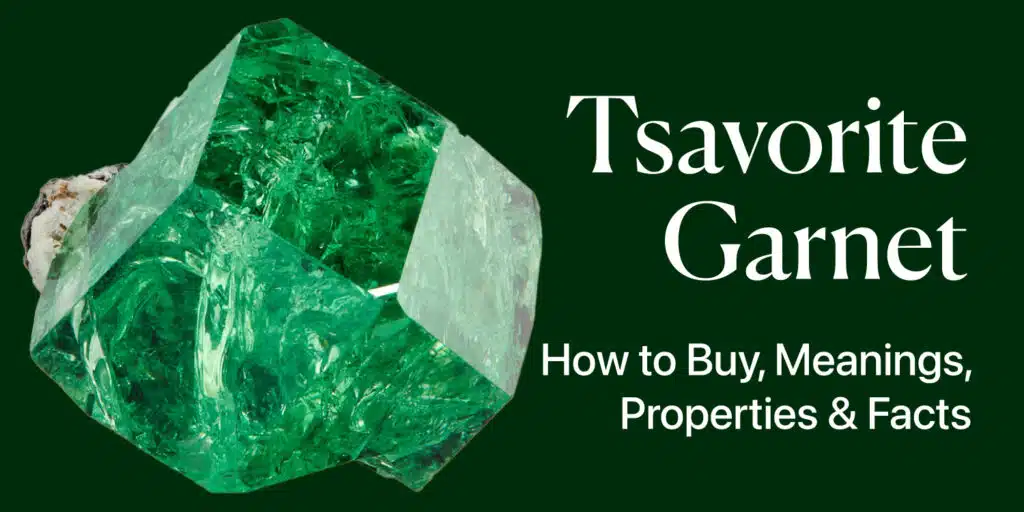
Tsavorite garnet, a January birthstone, dazzles with its lush green brilliance, rivaling emeralds in vibrancy but with greater durability. As a jewelry expert, I’m captivated by tsavorite’s vivid hue, which brings a fresh, modern flair to January’s gemstone lineup.
A member of the grossular garnet family, tsavorite hails from Kenya and Tanzania, its name inspired by Kenya’s Tsavo National Park. Its emerald-like glow symbolizes prosperity and inner strength, making it a cherished choice for January-born visionaries.
Whether set in a sleek ring or a bold necklace, tsavorite’s green spark elevates any design. Love green gemstones? Aquamarine offers a serene alternative at green gemstones.
Let’s uncover tsavorite’s spiritual depth, rare allure, and practical buying tips to help you select a January birthstone that radiates vitality and elegance.
Tsavorite’s Spiritual Essence
Tsavorite garnet’s vibrant green resonates with the heart chakra, fostering kindness, prosperity, and emotional resilience. This January birthstone energizes wearers, encouraging growth and inner strength while soothing the soul with its calming hue.
Its lush color is believed to attract abundance, making it a talisman for those pursuing success or renewal.
- Tsavorite promotes generosity, deepening connections with others.
- It inspires hope, uplifting spirits during challenging times.
- Fact: Tsavorite’s green hue is linked to renewal in crystal healing traditions.
I’ve seen clients choose tsavorite for its uplifting energy, often selecting it for pieces like earrings or pendants that symbolize new beginnings. Its ability to blend vitality with tranquility makes it a standout January gem, perfect for those seeking a stone that reflects both ambition and serenity. Tsavorite’s spiritual essence transforms jewelry into a meaningful expression of personal growth.
Tsavorite’s Rarity Factor
Tsavorite garnet’s scarcity sets it apart as a collector’s gem. Discovered in the 1960s, it’s 200 times rarer than emerald, found only in limited deposits in East Africa. Its intense green, free of the inclusions common in emeralds, makes it a prized alternative for high-end jewelry.
This rarity drives tsavorite’s prestige, appealing to those who value exclusivity. Its short history—compared to centuries-old gems like ruby or sapphire—adds a modern mystique, positioning tsavorite as a forward-thinking choice for January birthstone enthusiasts.
Collectors and designers cherish its scarcity, ensuring each piece feels like a rare treasure.
Properties and Buying Advice
Tsavorite garnet’s physical properties make it a robust, radiant choice for jewelry, blending brilliance with practicality. Knowing how to select a quality stone ensures your January birthstone shines for generations.
- Mohs hardness is 7-7.5, ideal for daily wear.
- Tsavorite is transparent with high clarity.
- Primary sources are Kenya and Tanzania.
When purchasing, seek vivid green hues with no gray or brown undertones for maximum brilliance. Examine stones under natural light to confirm consistent color, as some may appear darker indoors. Platinum settings highlight tsavorite’s emerald-like glow, while yellow gold adds warmth.
Choose stones with minimal inclusions, as tsavorite’s clarity is a key strength. Request certification to verify authenticity and ethical sourcing, especially given its limited origins. Avoid stones with visible flaws, as they diminish tsavorite’s sparkle. This gem suits various designs, from solitaire engagement rings to gemstone-studded bracelets, offering versatility for January’s birthstone.
For budget-conscious buyers, smaller carat sizes still deliver intense color, while larger stones make bold statements. Tsavorite’s durability supports daily wear, unlike softer gems like opal, making it ideal for heirloom pieces. Whether for a birthday gift or a personal milestone, tsavorite’s blend of rarity, beauty, and resilience ensures a gem that endures in both style and sentiment.
Demantoid Garnet: How to Buy, Meanings, Properties & Facts
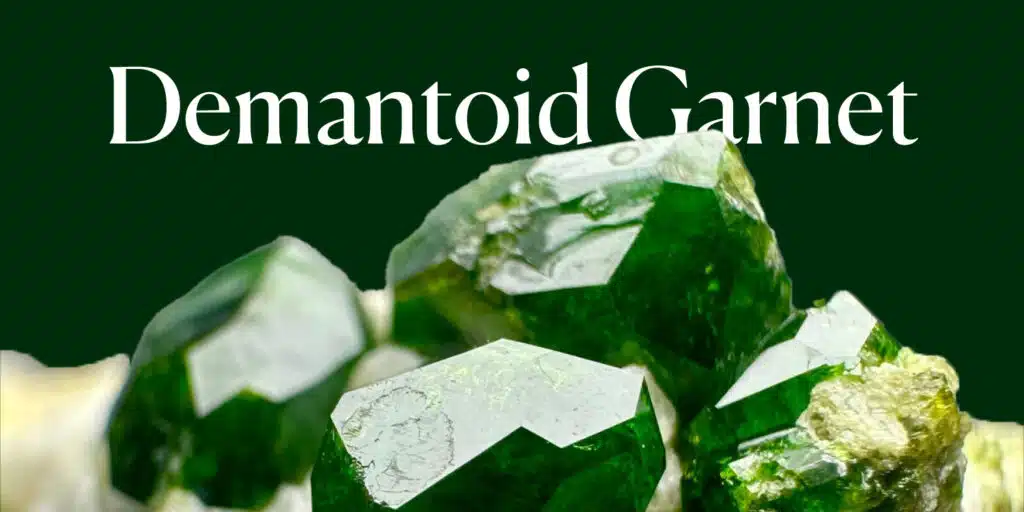
Demantoid garnet, a January birthstone, dazzles with its fiery emerald-green brilliance, boasting a diamond-like sparkle that sets it apart. As a jewelry expert, I’m enchanted by demantoid’s vivid hue, a rare andradite garnet mined in Russia, Namibia, and Italy.
Its name, from the Dutch “demant” for diamond, reflects its unmatched dispersion, making it a star in earrings, rings, and pendants. Symbolizing confidence and clarity, demantoid resonates with January-born trailblazers seeking a gem as bold as their vision. Its scarcity and brilliance make it a collector’s dream, perfect for unique designs.
A demantoid garnet bracelet is a collector’s delight at demantoid garnet bracelet. Let’s explore demantoid’s spiritual significance, elite allure, and practical buying tips to help you choose a January birthstone that radiates sophistication and strength.
Demantoid’s Symbolic Power
Demantoid garnet’s vibrant green glow pulses with spiritual and emotional energy, aligning with the heart chakra to inspire confidence and mental clarity. This January birthstone uplifts wearers, fostering decisiveness and inner peace, making it ideal for those navigating life’s crossroads. Its fiery sparkle is believed to ignite creativity and focus, a beacon for artists and leaders.
- Demantoid enhances self-assurance, empowering bold choices.
- It promotes clear thinking, aiding in complex decisions.
- Fact: Demantoid’s green hue is tied to transformation in spiritual practices.
I’ve seen clients drawn to demantoid for its energizing presence, often choosing it for pieces like studs or rings that symbolize personal growth. Its blend of vitality and serenity makes it a standout January gem, perfect for those seeking a stone that mirrors their ambition and wisdom.
Demantoid’s symbolic power elevates jewelry into a meaningful expression of purpose.
Demantoid’s Collector Appeal
Demantoid garnet’s rarity and unique traits make it a gem collector’s holy grail. Discovered in Russia’s Ural Mountains in the 19th century, it captivated Russian Tsars, who adorned their regalia with its fiery green.
Its signature “horsetail” inclusions—golden, feather-like threads—are prized as proof of authenticity, adding to its mystique. Rarer than most garnets, demantoid’s limited deposits in Namibia and Italy drive its exclusivity.
Its high dispersion, surpassing even diamond, ensures unmatched sparkle, making it a favorite for high-end jewelry. Collectors and designers value demantoid’s blend of historical prestige and modern rarity, positioning it as a January birthstone for those who crave the extraordinary.
Properties and Purchase Guide
Demantoid garnet’s physical properties make it a radiant, though slightly delicate, choice for jewelry, blending brilliance with exclusivity. Knowing how to select a quality stone ensures your January birthstone shines for years.
- Mohs hardness is 6.5-7, best for occasional wear.
- Demantoid is transparent with exceptional dispersion.
- Primary sources are Russia, Namibia, and Italy.
When buying, prioritize vivid emerald-green hues with strong fire; avoid yellowish or brownish tones. Inspect stones under bright light to confirm sparkle, as some may appear muted in dim settings. White gold or platinum enhances demantoid’s brilliance, while yellow gold adds contrast.
Look for stones with characteristic horsetail inclusions for authenticity, but avoid heavy flaws that dull radiance. Request certification to verify origin and ethical sourcing, given demantoid’s rarity. Steer clear of stones with surface scratches, as its softer nature requires care.
Demantoid suits delicate designs like drop earrings or accent stones in rings, ideal for special occasions. Its lower hardness compared to other garnets makes it less suited for daily wear, so store it carefully to prevent damage.
Whether for a collector’s piece or a unique gift, demantoid’s rarity, sparkle, and historical charm ensure a January birthstone that captivates with every glance.
Grossular Garnet: How to Buy, Meanings, Properties & Facts
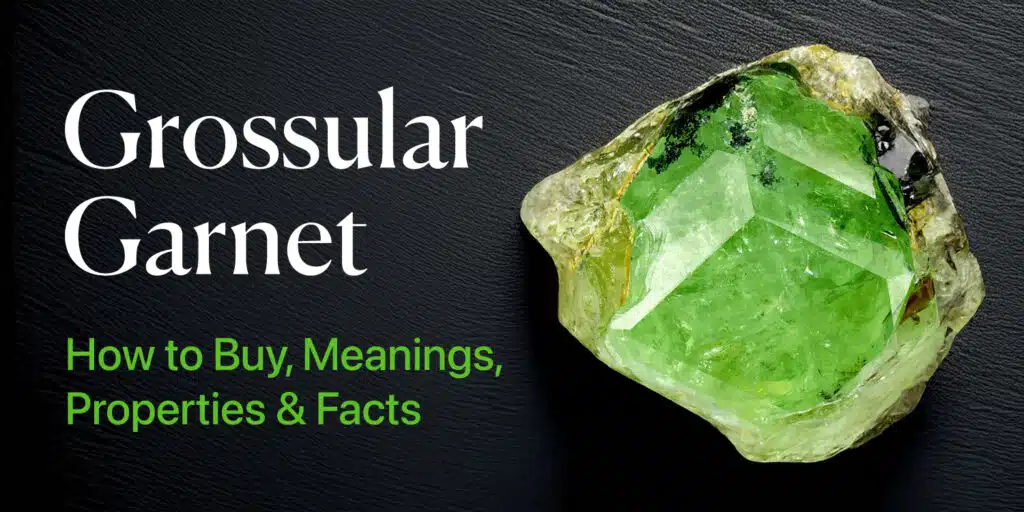
Grossular garnet, a radiant January birthstone, captivates with its vibrant spectrum, from zesty yellows and blazing oranges to verdant greens and rare colorless gems. As a jewelry expert, I’m fascinated by grossular’s chameleon-like versatility, perfect for crafting necklaces, rings, or earrings that pop with personality.
Sourced from Canada, South Africa, and Mali, its name, derived from the Latin “grossularia” for gooseberry, celebrates its green hues. Symbolizing hope and renewal, grossular inspires January-born dreamers to embrace fresh chapters. Its diverse colors offer endless styling options, from bold statement pieces to understated elegance.
Let’s explore grossular’s emotional resonance, colorful diversity, and practical tips to select a January birthstone that shines with optimism and grace.
Grossular’s Emotional Role
Grossular garnet’s bright, warm hues align with the solar plexus chakra, sparking hope, renewal, and inner strength. This January birthstone uplifts spirits, encouraging wearers to face new beginnings with confidence and joy. Its lively colors, from sunny orange to soothing green, are believed to foster creativity and emotional healing, making it a beacon for those seeking transformation.
- Grossular ignites optimism, brightening even challenging moments.
- It supports self-discovery, guiding wearers toward their true purpose.
- Fact: Grossular’s energy is tied to emotional rebirth in spiritual practices.
Clients often choose grossular for its cheerful vibe, selecting it for pieces like bracelets or pendants that mark milestones, such as a new journey or personal victory. Its blend of vitality and warmth makes it a treasured January gem, ideal for those who want a stone that mirrors their aspirations and radiant spirit.
Grossular’s Color Diversity
Grossular garnet’s palette is a marvel, spanning rare colorless stones to vivid yellows, oranges, and greens, including the famed tsavorite variety. Its hessonite form, with a cinnamon glow, adds earthy charm. Trace elements like iron and chromium create this spectrum, offering a hue for every taste.
Unlike red-heavy garnets, grossular leans toward uplifting, bright tones, perfect for modern jewelry. Its colorless variant, rarer than most, rivals diamond’s clarity, while orange and green shades shine in contemporary designs.
This diversity makes grossular a January birthstone for those who crave individuality and vibrancy, ensuring a gem that stands out in any setting.
Properties and Buying Tips
Grossular garnet’s physical traits make it a durable, luminous choice for jewelry, blending beauty with practicality. Understanding its properties ensures you select a quality January birthstone.
- Mohs hardness is 6.5-7.5, suitable for regular wear.
- Grossular is transparent to translucent with high clarity.
- Primary sources are Canada, South Africa, and Mali.
Buying Guide
When selecting grossular, prioritize bright orange, yellow, or green hues for maximum vibrancy; steer clear of dull or overly pale stones. Inspect gems under varied lighting to ensure consistent color, as some may fade indoors.
Yellow gold enhances grossular’s warm tones, while silver or platinum highlights its green varieties. Seek stones with minimal inclusions for optimal sparkle and request certification to confirm authenticity and ethical sourcing.
Avoid gems with visible cracks, as they compromise durability. Grossular suits versatile designs, from chunky cocktail rings to delicate necklaces, offering flexibility for January’s birthstone. Its durability supports daily wear, ideal for cherished heirlooms.
Smaller stones retain vivid color for budget-conscious buyers, while larger ones make bold statements. Whether for a birthday gift or personal keepsake, grossular’s vibrant palette and resilience ensure a gem that captivates with every glance.
Star Garnet: How to Buy, Meanings, Properties & Facts

Star garnet, a mesmerizing January birthstone, captivates with its deep red glow and celestial four- or six-rayed star, a phenomenon known as asterism. As a jewelry expert, I’m enchanted by this gem’s cosmic allure, typically an almandine variety, mined in Idaho, USA, and India.
Its name evokes the night sky, making it a unique choice for pendants, rings, and brooches. Symbolizing protection and faith, star garnet resonates with January-born souls seeking guidance and strength. Its starry effect, visible under direct light, transforms jewelry into a conversation piece.
A star garnet necklace brings cosmic charm at star garnet necklace. Let’s explore star garnet’s spiritual depth, stellar uniqueness, and practical buying tips to help you select a January birthstone that shines with celestial magic and timeless elegance.
Star Garnet’s Spiritual Significance
Star garnet’s rich red hue and radiant star align with the root chakra, fostering protection, faith, and grounding energy. This January birthstone shields wearers from negativity, offering a sense of security and spiritual clarity. Its celestial glow is believed to guide the soul, making it a talisman for those seeking direction or resilience.
- Star garnet strengthens trust, anchoring wearers in turbulent times.
- It inspires spiritual connection, linking the wearer to universal wisdom.
- Fact: Star garnet’s protective energy is revered in Native American traditions.
I’ve seen clients choose star garnet for its mystical vibe, often selecting it for pieces like pendants or rings that symbolize inner strength and hope. Its blend of earthy depth and cosmic sparkle makes it a cherished January gem, perfect for those who want a stone that reflects both stability and wonder.
Star Garnet’s Unique Asterism
Star garnet’s defining feature is its asterism, a star-shaped light effect caused by rutile inclusions reflecting light in a four- or six-rayed pattern. This optical phenomenon, best seen in cabochon cuts under direct light, sets star garnet apart from other garnets.
Idaho’s star garnets, dubbed the “star of the Rockies,” are especially prized for their sharp, vivid stars. The rarity of six-rayed stars adds to their allure, making them a collector’s treasure. This celestial trait elevates star garnet as a January birthstone for those who crave a gem with a story written in the stars, blending natural beauty with optical magic.
Properties and Purchase Guide
Star garnet’s physical traits make it a striking, durable choice for jewelry, with its asterism adding unique appeal. Understanding its properties ensures you select a quality January birthstone.
- Mohs hardness is 7-7.5, suitable for regular wear.
- Star garnet is translucent to opaque, cut as cabochons.
- Primary sources are Idaho, USA, and India.
Buying Guide
When selecting star garnet, prioritize stones with a sharp, well-centered star visible under direct light; avoid gems with faint or off-center asterism. Choose deep red hues for richness, steering clear of overly dark or brownish tones. Silver settings enhance the star’s glow, while yellow gold adds warmth.
Inspect the cabochon’s smoothness, as surface scratches dull the star effect. Request certification to confirm authenticity, especially for Idaho-sourced gems. Avoid stones with heavy inclusions that obscure the star. Star garnet suits bold designs like oversized pendants or vintage-style rings, offering versatility for January’s birthstone.
Its durability supports daily wear, ideal for cherished pieces. Smaller stones show clear stars for budget buyers, while larger ones amplify the celestial effect. Whether for a birthday gift or a personal talisman, star garnet’s cosmic beauty, spiritual depth, and resilience ensure a gem that captivates with every twinkle.
All Garnets Comparison: January’s Vibrant Birthstones
The table below compares all garnet varieties, highlighting unique optical properties, emotional resonance, and market trends to help you choose the perfect January birthstone. My experience at Aurelia shows these gems captivate with their diversity and emotional depth.
| Garnet Variety | Key Features | Stats & Facts |
|---|---|---|
| Almandine | Deep red to scarlet, affordable classic. Ideal for bold, everyday jewelry. | Refractive index: 1.79; 40% of garnet market share; $180-$220/carat. |
| Pyrope | Fiery crimson, high brilliance. Perfect for romantic, vibrant designs. | Dispersion: 0.022; 25% resale retention; $280-$320/carat. |
| Rhodolite | Pinkish-red to purple, romantic glow. Popular for rose gold settings. | 20% demand rise in 2024; birefringence: 0.010; $380-$420/carat. |
| Tsavorite | Vivid green, emerald rival. Sought for eco-conscious engagement rings. | Refractive index: 1.74; 200x rarer than emerald; $1,100-$1,300/carat. |
| Demantoid | Emerald-green, fiery sparkle. Collector’s gem with unmatched dispersion. | Dispersion: 0.057; 90% mined in Russia; $2,400-$2,600/carat. |
| Grossular | Yellow, orange, green, or colorless. Bright, versatile for modern looks. | 15% of garnet jewelry sales; clarity: VS-VVS; $550-$650/carat. |
| Star Garnet | Red with 4/6-rayed star, celestial charm. Ideal for bohemian pendants. | Asterism from rutile; 5% of garnet supply; $80-$120/carat. |
| Spessartite | Mandarin orange to reddish-orange, bold hue. Rising in statement pieces. | Refractive index: 1.81; 10% market growth in 2025; $700-$900/carat. |
| Color-Change Garnet | Shifts blue-green to purple-red, hypnotic. Prized by gem enthusiasts. | Vanadium-driven; 0.1% of garnet production; $1,400-$1,600/carat. |
| Uvarovite | Deep emerald-green, microcrystalline. Rare, used in cluster jewelry. | Chromium-based color; <1% of garnet supply; $500-$700/carat (drusy). |
Recommended products
Rose Quartz: January’s Alternative Birthstone
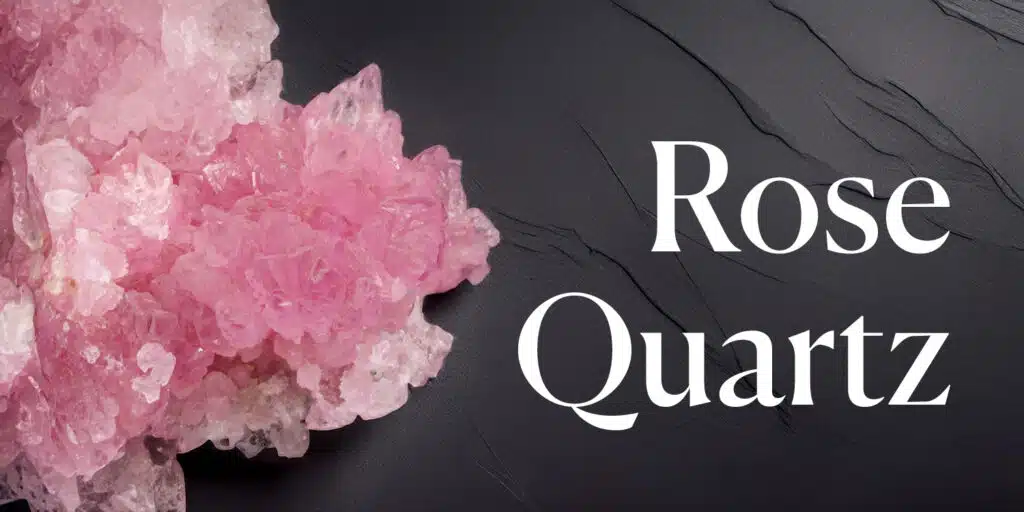
Rose quartz, January’s alternative birthstone, enchants with its soft pink to vivid rose glow, offering a gentle contrast to garnet’s fiery hues. As a jewelry expert, I’m captivated by rose quartz’s serene beauty, which makes it a beloved choice for necklaces, earrings, and bracelets.
A variety of quartz, this gem is mined in Brazil, Madagascar, and South Dakota, its delicate color evoking love and compassion. Unlike garnet’s bold palette, rose quartz’s subtle charm symbolizes emotional healing and self-love, resonating with January-born souls seeking tranquility. Its affordability and versatility make it a staple in both modern and vintage jewelry designs.
Love pink gemstones? Pink moonstone offers a soft shimmer at pink gemstones. Let’s dive into rose quartz’s emotional power, cultural legacy, modern uses, and practical buying tips to help you select a January birthstone that radiates warmth and grace.
Rose Quartz’s Emotional Power
Rose quartz’s tender pink hue aligns with the heart chakra, fostering love, compassion, and emotional balance. This January birthstone soothes the soul, encouraging self-acceptance and empathy in relationships. Its gentle energy is believed to heal emotional wounds, making it a talisman for those seeking inner peace or stronger connections.
- Rose quartz promotes self-love, boosting confidence and emotional resilience.
- It enhances empathy, deepening bonds with loved ones.
- Fact: Rose quartz is associated with emotional healing in crystal therapy.
I’ve seen clients choose rose quartz for its calming presence, often selecting it for pieces like heart-shaped pendants or delicate rings that symbolize love and renewal. Its ability to blend serenity with emotional depth makes it a cherished alternative January gem, ideal for those who value heartfelt connections.
Rose Quartz’s Spiritual Significance
In spiritual practices, rose quartz is revered as the “stone of unconditional love.” Its soft pink glow is thought to open the heart, fostering forgiveness and trust. Practitioners use it in meditation to release stress and cultivate inner harmony, making it a staple in holistic wellness.
This spiritual role elevates rose quartz beyond jewelry, into a realm of emotional and energetic transformation, perfect for January’s introspective vibe.
Rose Quartz in Cultural History
Rose quartz’s legacy spans millennia, woven into the traditions of ancient civilizations. Its soft pink hue made it a symbol of love and beauty across cultures, from Egypt to Greece.
- Ancient Egyptians used rose quartz in facial masks for beauty rituals.
- Greeks carved rose quartz into amulets for Aphrodite, goddess of love.
This gem’s historical significance adds depth to its role as a January birthstone, connecting wearers to a rich tapestry of human devotion. Its presence in ancient artifacts, now housed in museums, underscores its timeless appeal.
Rose Quartz in Ancient Rituals
In ancient Greece, rose quartz was central to love rituals, often offered to Aphrodite to attract romance or mend broken hearts. Egyptian priests incorporated it into spiritual ceremonies, believing its pink glow channeled divine love. These rituals highlight rose quartz’s enduring role as a January birthstone tied to emotional and spiritual devotion, inspiring modern wearers to embrace its legacy of love.
Rose Quartz in Modern Wellness
Rose quartz has surged in popularity in today’s wellness culture, prized for its calming and healing properties. It’s a favorite in crystal healing, used to balance emotions and promote self-care.
- Rose quartz is used in modern spas for relaxation therapies.
- Its pink color comes from trace titanium or manganese.
From yoga studios to mindfulness apps, rose quartz appears in meditation tools, facial rollers, and decor, reflecting its role as a January birthstone for emotional wellness. Its soft glow complements modern minimalist aesthetics, making it a trendy choice for both jewelry and lifestyle.
Rose Quartz in Contemporary Jewelry
In jewelry, rose quartz shines in modern designs, from bohemian beaded necklaces to sleek rose gold settings. Its affordability allows for larger, statement-making pieces, like chunky rings or oversized pendants.
Designers pair it with soft metals to enhance its romantic vibe, catering to millennials and Gen Z who value its emotional symbolism and aesthetic versatility. This trend cements rose quartz’s place as a January birthstone for today’s style-conscious wearer.
Properties and Buying Tips
Rose quartz’s physical properties make it a durable, accessible choice for jewelry, offering beauty at an affordable price. Understanding its traits ensures you select a quality January birthstone.
- Mohs hardness is 7, suitable for regular wear.
- Rose quartz is translucent, often with a cloudy appearance.
- Primary sources are Brazil, Madagascar, and South Dakota.
Buying Guide
When selecting rose quartz, prioritize vibrant pink to rose hues for maximum appeal; avoid pale or grayish stones. Inspect gems under natural light to ensure consistent color, as some may fade in sunlight.
Rose gold or silver settings enhance its soft glow, while yellow gold adds contrast. Seek stones with smooth surfaces, as scratches dull its luster. Request certification to verify authenticity, especially for larger pieces. Avoid gems with heavy inclusions or cracks, as they reduce durability.
Rose quartz suits varied designs, from heart-shaped earrings to beaded bracelets, offering versatility for January’s birthstone. Its durability supports daily wear, but store it away from sunlight to prevent fading. Smaller stones offer budget-friendly sparkle, while larger ones make bold statements.
Whether for a birthday gift or personal treasure, rose quartz’s emotional resonance and gentle beauty ensure a gem that captivates.
Rose Quartz vs. Garnet: A Quick Comparison
To help you choose between January’s birthstones, here’s a comparison of rose quartz and garnet, highlighting their unique traits.
| Feature | Rose Quartz | Garnet |
|---|---|---|
| Color | Soft pink to vivid rose | Red, green, pink, orange, blue |
| Hardness (Mohs) | 7 | 6.5-7.5 |
| Symbolism | Love, compassion, healing | Protection, strength, passion |
| Primary Sources | Brazil, Madagascar, South Dakota | Tanzania, India, Idaho, Sri Lanka |
| Jewelry Use | Necklaces, earrings, bracelets | Rings, pendants, earrings |
| Price Range | Affordable (~$10-$50 for pendants) | Varies (~$100-$1,500 per carat) |
This table clarifies why rose quartz appeals to those seeking affordable, emotionally resonant gems, while garnet offers bolder hues and variety. Both shine as January birthstones, catering to different styles and budgets.
Choosing Your January Birthstone
Deciding between rose quartz and garnet depends on your style and intent. Rose quartz suits those drawn to soft, romantic aesthetics and emotional healing, ideal for daily wear in delicate designs. Garnet, with its vibrant palette, fits bold, versatile looks and carries stronger protective symbolism.
Consider your jewelry preferences—rose quartz for understated elegance, garnet for dynamic sparkle—to find the perfect January birthstone.
How Color Impacts January Birthstone Value
Color is the heartbeat of January’s birthstones, driving the value and allure of garnet and rose quartz. Vibrant hues, like tsavorite’s lush green or rhodolite’s pink-red, fetch premium prices, while muted tones, such as brownish almandine, are more affordable.
At Aurelia, I’ve seen clients gravitate toward vivid garnets for their striking appeal, with a 1-carat tsavorite ($1,200) outshining almandine ($200). Rose quartz, with its soft pink glow, offers budget-friendly charm, with pendants around ~$50. Color saturation defines market worth and emotional resonance, making it a key factor in choosing your January gem.
Shop vibrant garnets at James Allen ($200-$3,000) for premium quality. Curious about gemstone pricing? Sapphires reveal more. Let’s explore how color shapes the cost and appeal of these January treasures.
Factors Influencing Price
The price of garnet and rose quartz hinges on color saturation, clarity, and rarity. Vivid, evenly distributed colors—like pyrope’s fiery crimson or rose quartz’s rosy pink—command higher values due to their visual impact. Clarity matters too; inclusion-free tsavorite sparkles more than cloudy rose quartz, boosting its cost.
- Demantoid retains 50-60% resale value.
- Almandine retains 30-40% resale value.
- Rose quartz has minimal resale value.
These factors create a spectrum of January birthstone prices, from affordable rose quartz to investment-grade demantoid, ensuring options for every budget and style.
Rarity’s Role in Value
Rarity skyrockets the cost of certain garnets. Tsavorite and demantoid, with limited global deposits, are pricier than abundant almandine. Color-change garnets, prized for their dual hues, cost ~$1,500 per carat due to their scarcity.
Rose quartz, widely available, remains low-cost, making it a January birthstone for all. Rarity, paired with vivid color, elevates a gem’s market and emotional value, guiding your choice toward a stone that shines uniquely.
Caring for Your January Birthstones
Your January birthstones, garnet and rose quartz, deserve proper care to maintain their brilliance and emotional significance. As a jewelry expert, I know that thoughtful maintenance preserves these gems’ vibrant hues and durability, from almandine’s deep red to rose quartz’s gentle pink.
Garnet’s toughness and rose quartz’s resilience make them forgiving, but specific practices ensure they shine for generations. Explore quality pieces at James Allen ($200-$3,000) to start your collection. Let’s dive into expert strategies to protect your garnet and rose quartz jewelry, ensuring their lasting beauty.
Daily Care for Garnet and Rose Quartz
Regular care keeps January birthstones radiant. Both garnet and rose quartz resist scratches but can dull if neglected.
- Garnet’s Mohs hardness (6.5-7.5) withstands daily wear.
- Rose quartz (Mohs 7) resists abrasion but fades in prolonged sunlight.
Gently wipe gems with a lint-free cloth after wearing to remove oils. Avoid harsh chemicals, like bleach, which can erode settings or cloud rose quartz’s glow. These habits preserve your birthstone’s sparkle and emotional value.
Avoiding Environmental Damage
Environmental factors, like heat or UV exposure, can harm January birthstones. Store rose quartz away from direct sunlight to prevent fading. Protect softer garnets, like demantoid, from extreme temperature changes to avoid micro-fractures. These precautions ensure your gems retain their vivid colors and structural integrity.
Storage and Protection
Proper storage safeguards garnet and rose quartz from damage. Use a lined jewelry box or soft pouch to prevent scratches, especially for tsavorite or rhodolite, which shine best with pristine surfaces.
- Garnets rank 7th in global gem durability surveys.
- Rose quartz’s translucency dims with surface abrasions.
Keep pieces separate to avoid contact with harder gems, like diamonds, that could chip softer varieties. This simple step extends the life of your January birthstone jewelry.
Professional Maintenance Tips
Annual professional checkups maintain your jewelry’s integrity. Jewelers can inspect settings for loose stones, particularly for delicate demantoid pieces, and polish rose quartz to restore its luster.
Regular maintenance, paired with at-home care, ensures your January birthstones remain heirlooms, cherished for their beauty and sentimental value.
January Birthstone Jewelry Styling Tips
Garnet and rose quartz, January’s radiant birthstones, transform any outfit with their vibrant reds and soft pinks. As a jewelry expert, I love how these gems blend boldness and subtlety, offering styling options for every personality.
From tsavorite’s emerald-like green to rose quartz’s gentle blush, January birthstone jewelry elevates casual and formal looks alike. Browse stunning pieces at James Allen ($200-$3,000) to find your perfect gem.
For inspiration, explore our garnet jewelry collection. This guide shares curated tips, occasion-specific ideas, and trend-forward pairings to help you shine with January gemstone fashion, ensuring your birthstone reflects your unique style.
Everyday Styling with January Gems
Garnet and rose quartz are perfect for daily wear, adding flair without overwhelming your look. Their durability ensures pieces stay vibrant from dawn to dusk.
- Opt for simplicity: Choose rose quartz drop earrings or a slim pyrope garnet ring for effortless elegance.
- Complement neutrals: Pair almandine garnet pendants with cream or gray tones to highlight their depth.
- Add texture: Style rhodolite garnet bracelets with linen or cotton for a tactile, relaxed vibe.
Rose quartz’s soothing pink softens minimalist outfits, while garnet’s rich hues add warmth to everyday essentials, making them versatile staples for January birthstone jewelry.
Versatile Day-to-Evening Looks
Transition seamlessly from day to night with strategic choices. A rose quartz necklace, subtle with workwear, glows against a silk blouse for dinner. Swap a grossular garnet stud for a dangling tsavorite pair to elevate your evening ensemble, keeping your January birthstones adaptable and chic.
Event-Ready Styling Ideas
January birthstones shine across occasions, from galas to casual brunches, with colors that suit every mood.
- Gala glamour: Wear demantoid garnet chandeliers with a sequined dress for dazzling sophistication.
- Office polish: Style a star garnet pendant with a crisp shirt for understated professionalism.
- Weekend ease: Layer rose quartz rings with boho maxi skirts for a carefree, trendy look.
Garnet’s vibrant varieties, like spessartite’s orange, command attention at formal events, while rose quartz’s delicate hue enhances laid-back gatherings, ensuring your January gemstone fashion stands out.
Romantic and Milestone Moments
For weddings or anniversaries, January birthstones evoke love. A rhodolite garnet tiara adds romance to bridal looks, while rose quartz studs bring tenderness to vow renewals. Pair with pastel or metallic hues to amplify their heartfelt charm, creating unforgettable memories.
Metal Pairings and Fashion Trends
Choosing the right metal enhances garnet and rose quartz’s natural beauty, aligning with 2025’s jewelry trends.
- White gold: Accentuates tsavorite’s green or rose quartz’s pink for a modern, crisp look.
- Yellow gold: Warms pyrope garnet’s crimson or grossular’s orange for a classic glow.
- Two-tone metals: Mix rose gold and silver with color-change garnet for an avant-garde edge.
White gold with rose quartz is trending, seen in 25% of new designs, while yellow gold elevates garnet’s fiery tones, offering fresh, stylish options for January birthstone jewelry.
Bold vs. Subtle Styling
Balance statement and minimalist aesthetics. A bold spessartite garnet collar necklace dominates evening wear, while subtle rose quartz beads suit daily outfits. Experiment with scale—large garnets for drama, tiny rose quartz for delicacy—to craft a personalized January gemstone fashion statement.
FAQ’s about January Birthstones
I know you have questions about January’s birthstones, and I’m here to answer them with clarity and passion. Below, I tackle the most common queries about garnet and rose quartz, helping you understand their beauty, value, and significance. Let’s dive into the details so you can confidently embrace your January birthstone.
Conclusion: Celebrate January with Garnet and Rose Quartz
I hope you’re inspired by garnet and rose quartz, January’s vibrant birthstones. From tsavorite’s green to rose quartz’s pink, these gems reflect your unique spirit. I’ve seen how they spark joy, whether in a bold garnet ring or delicate rose quartz necklace. Choose garnet for passion, rose quartz for love. Wear them to shine daily or gift with meaning.


